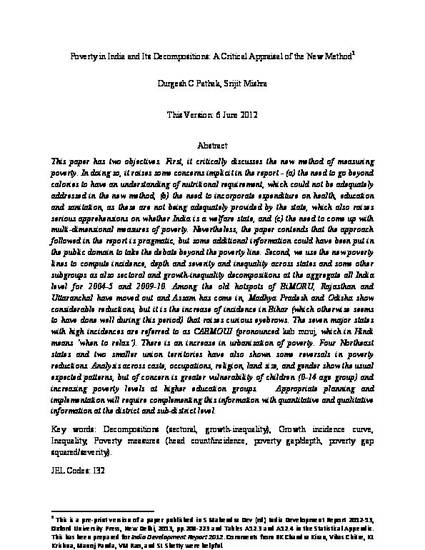
This paper has two objectives. First, it critically discusses the new method of measuring poverty. In doing so, it raises some concerns implicit in the report - (a) the need to go beyond calories to have an understanding of nutritional requirement, which could not be adequately addressed in the new method, (b) the need to incorporate expenditure on health, education and sanitation, as these are not being adequately provided by the state, which also raises serious apprehensions on whether India is a welfare state, and (c) the need to come up with multi-dimensional measures of poverty. Nevertheless, the paper contends that the approach followed in the report is pragmatic, but some additional information could have been put in the public domain to take the debate beyond the poverty line. Second, we use the new poverty lines to compute incidence, depth and severity and inequality across states and some other subgroups as also sectoral and growth-inequality decompositions at the aggregate all India level for 2004-5 and 2009-10. Among the old hotspots of BiMORU, Rajasthan and Uttaranchal have moved out and Assam has come in, Madhya Pradesh and Odisha show considerable reductions, but it is the increase of incidence in Bihar (which otherwise seems to have done well during this period) that raises curious eyebrows. The seven major states with high incidences are referred to as CABMOUJ (pronounced kab mouj, which in Hindi means ‘when to relax’). There is an increase in urbanisation of poverty. Four Northeast states and two smaller union territories have also shown some reversals in poverty reductions. Analysis across caste, occupations, religion, land size, and gender show the usual expected patterns, but of concern is greater vulnerability of children (0-14 age group) and increasing poverty levels at higher education groups. Appropriate planning and implementation will require complementing this information with quantitative and qualitative information at the district and sub-district level.
- Decompositions (sectoral,
- growth-inequality),
- Growth incidence curve,
- Inequality,
- Poverty measures (head count/incidence,
- poverty gap/depth,
- poverty gap squared/severity)
Available at: http://works.bepress.com/srijit_mishra/93/
